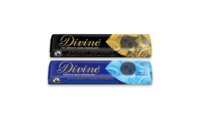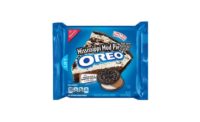Sweet Value at
Dollar General
This fast-growing chain of more than 7,500 stores is where many of the nation’s low-income consumers—and other smart shoppers—go to find a deal on candy. Customer representative Ken Smith is committed to giving these discriminating clients what they want—quantity and quality at a bargain price. By Mary Ellen Kuhn
Ken Smith understands the
psyche of the low-income consumer. That understanding is one of the things
that comes across most clearly in the course of a conversation with the
likable and straight-talking candy category manager for Dollar General
Corp.
Category manager is not Smith’s title, by the
way, despite the fact that he handles purchasing for candy as well as other
food and beverage products. His title is customer representative, a term
that reflects the emphasis that this fast-growing Goodlettsville,
Tenn.-based retail chain places on serving its core
constituency—consumers of modest means.
“Our main focus here is on the low-income
consumer, and that drives most of our decision processes,” says
Smith, “because we know that if we can service that consumer, then we
can service any consumer.
“The low-income consumer has to be one of the
most savvy consumers you’ll ever meet because they spend more time
thinking about what they can do without,” he explains. “They
may need $10 worth of merchandise, but they’ve only got $8 to spend,
so every time they go into a store, they’re making a decision on
‘what I don’t have to have.’ That makes them savvy. They
know who has the best price everyday. So if we can service that consumer,
well, then the rest is easy.”
Delivering value
Servicing that consumer affects the candy assortment
and the way it is merchandised. For example, you will find only a few
novelty/interactive candy SKUs in Dollar General stores. Instead, the candy
assortment is focused on peg bags, laydown bags and candy bar multi-packs.
Smith presents the following hypothetical scenario by
way of explanation. “The low-income consumer—if she has a
dollar, would her decision be to purchase one item for her child or would
her decision be to spend that dollar on a bag of something that she can
share with that child and the rest of the family? It becomes a matter of
taking care of multiple people vs. taking care of one.”
What is more, Smith explains, “Most of our
business is done by the female shopper on her way to work, on the way back
from work, or on her lunch hour; you don’t have the assistance of the
child on the purchase decision.”
As it does in many categories at Dollar General,
private-label represents an important piece of the chain’s candy
business.
Dollar General has a two-tiered private-label candy
assortment. The Clover Valley label is used on national brand equivalent
(NBE) products—a rating that is measured in a rigorous program of
annual consumer testing that Smith oversees.
Non-NBE private-label candy is sold under Dollar
General’s American Value label.
Pricing practices
Everyday low prices and a straightforward pricing
structure are key components of Dollar General’s approach to retail.
This too is designed to accommodate the typical money-conscious Dollar
General patron.
“To a low-income consumer, there is nothing more
embarrassing than getting to the register and not having enough
money,” says Smith. “Pre-pricing helps them [avoid that].
We’ve got easy price points. They can add it in their head. And they
don’t have to worry about dealing with the embarrassment of showing
up at the register and not knowing how much the product is.”
Dollar General has just 17 standard price points
ranging from 4/$1 to $20, with stops in between at $2/3, $2/5, and $10, to
cite just a handful of them. Vendors are strongly encouraged to pre-print
prices on their packaging.
Of course, just because Dollar General shoppers tend
to approach candy purchasing pragmatically doesn’t mean that they are
immune to its impulse appeal.
A candy destination? Not necessarily
“My personal opinion is that I don’t think
that anybody comes to our stores just to buy candy,” says Smith.
“I think they buy candy as an impulse item. And that’s the way
I’ve gone at my assortment— packaging, everything. It’s
just my opinion, but I think that as long as I
maintain that view, it will force me to try to offer even more value to the
consumer.”
Dollar General showcases candy bars and impulse single
SKUs at the front of the store on a four-sided wire display fixture.
Offerings range from candy bars priced at either 2/$1 or 3/$1, candy in
theater boxes priced at $1, and even kids’ items like lollipops
that are 10 for $1.
The chain also makes use of the occasional display
shipper, particularly if it can be used as a sidewing. Due to space
constraints, there’s little room for anything else, although Smith is
doing what he can to take advantage of the marketing muscle that major
vendors are putting behind their brands.
For example, he notes, “We’ve just started
doing some limited edition products. We’re trying to be more creative
in creating sidewing displays and things like that to take advantage of the
tremendous amount of marketing that manufacturers are doing and to kind of
ride that wave.”
In addition, he continues, “We have taken
advantage of suggestive selling programs in our
stores that have done extremely well—where the clerk would suggest to
the consumer, ‘Would you like a Snickers bar? or Would you like a
Hershey’s bar?’”
Working within limits
Just as the vast majority of the consumers it serves
are living their lives under financial constraints, Dollar General buyers
operate under constraints as well—particularly when it comes to space
and pricing.
The average size for a Dollar General store is just
6,800 square feet, so there’s simply not a lot of room to showcase an
endlessly enticing assortment of candy.
Still, the chain manages to accommodate an everyday mix
of approximately 250 candy SKUs in line and at the front end, with an
additional 200 to 300 seasonal items stocked each year.
“There are a lot of things that we would like to
do that we can’t do,” Smith concedes. “When you’ve
got a small box, you don’t have the luxury of saying, ‘I can do
all of this stuff, and I can take a chance.’ I’m looking for
the best of the best. If a manufacturer has five SKUs, then maybe I only
want the one best-selling SKU.
“Space is always an issue, so we have to be more
innovative as to how we can display more product.”
As for the pricing constraints, Smith shares the
following example. “Let’s say a manufacturer takes a price
increase on an item that I’ve been retailing for $1. In most worlds,
they go up a dime, you go up a dime so your margins are the same. I
don’t have that option.”
Moving the price up to the next Dollar General price
point of $1.50 (i.e. 2/$3) wouldn’t make sense, of course. “So
what you end up doing is saying, “Hey, Mr. Manufacturer, how can we
come up with a package that will give me the same cost per ounce, but
it’s a different package size? And that is how a lot of product
development comes about. Fixed price points make you walk away from a lot
of things that you would do—if the manufacturer isn’t flexible
and willing to listen and adjust.”
Fortunately, Smith observes the significance of the
once humble but now increasingly powerful dollar channel is no longer lost
on most vendors. “Between when I started in candy [six years ago] and
today, it’s 360 degrees [different],” he reflects. “There
are manufacturers who wouldn’t even want to come for an appointment,
and now they’re beating down the door. Everyone has recognized the
potential of the dollar industry, and most of the majors have set up
dollar-specific teams.”
Fast Facts About Dollar General
Headquarters: Goodlettsville,
Tenn.
Annual Sales: $7.7
billion
Brief History: Founded
as a wholesale business in 1939, Dollar General pioneered the dollar store
concept in 1955 with stores in which everything was sold for $1.
Strategic Mission: Supplying
low-income and lower-middle-income consumers with "consumable
basics"—merchandise that is frequently used and replenished such
as food, snacks, health and beauty aids and cleaning supplies in addition
to a selection of apparel, housewares and seasonal goods—all sold at
everyday low prices.
Surprising Statistic:
Households with incomes in excess of $50,000 represent the fastest-growing
segment of Dollar General shoppers, despite the fact that the chain remains
focused on its core lower- and lower-middle-income customers.
Getting to Know Ken Smith
For 10 years before joining the Dollar General team in
1992, Ken Smith worked in operations for McCrory Corp., the now defunct
five-and-dime-store chain. It was a fitting preparation, given that for
many lower-income consumers residing in small towns and rural settings, the
dollar store fills a niche similar to the old five-and-ten-cent
stores—supplying an affordable shopping experience for life’s
necessities—and the occasional sweet treat.
Smith joined Dollar General in operations, working
first as district manager and later moving to the corporate office. He has
been buying candy for Dollar General for about six years.
Family: Wife, Cheryl;
she and Ken will be married 20 years in July. Two daughters, Brandi, just
graduating from high school; and Kayla, who will start seventh grade in the
fall.
Words to Live By: "Nothing
is worth more than it comes to." They are the words of Dollar General
co-founder Cal Turner Sr. What it means, Smith explains, is "that the
consumer makes the decision about the worth of an item."
Best Part of the Job: "Having
grown up a low-income consumer, knowing that I can help make decisions to
deliver more value to that person who needs value [is
meaningful.]"
Time Management Strategies: "There’s
not a day that I do not have 10 things on my plate that are all equally
important. So you have to prioritize a whole lot. There is very little
routine in our days."
Management Philosophy: "I
am a firm believer that a leader is no better than all the people on his
team."
Outside Interests: Old
cars, fishing, team sports, and, occasionally, horticulture.
FAQs on Vendor Relationships
As Answered by Ken Smith
How do you get to be a Dollar General vendor?
"There is no one formula, no written formula, if
you will, for doing business with Dollar General. Pretty much, if you have
a quality product and you have great pricing and you’re willing to
listen, then the door’s open.
"The people that tend to have the hardest time
doing business here are the ones that come in and basically say, "This
is what I have, take it or leave it. Usually, we don’t do a lot of
business with those people."
What’s the key to a successful retailer/vendor
partnership?
"I think the key [to sucess] in our private-label
as well as in our branded business is where we’ve partnered with
manufacturers—they to learn our business and me to learn their
business. We learn where we can be the most efficient in helping each
other. If you look at it as a partnership, then that changes the whole
playing field…the potential for growth is boundless."






